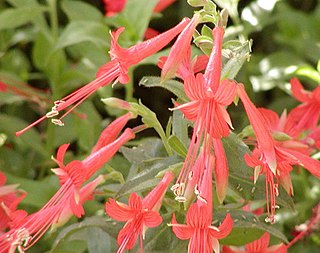
Epilobium canum, also known as California fuchsia or Zauschneria, is a species of willowherb in the evening primrose family (Onagraceae). It is native to dry slopes and in chaparral of western North America, especially California. It is a perennial plant, notable for the profusion of bright scarlet flowers in late summer and autumn.

Chamaenerion angustifolium is a perennial herbaceous flowering plant in the willowherb family Onagraceae. It is known in North America as fireweed, in some parts of Canada as great willowherb, in Britain and Ireland as rosebay willowherb, and traditionally known as Saint Anthony's Laurel amongst other variants. It is also known by the synonyms Chamerion angustifolium and Epilobium angustifolium. It is native throughout the temperate Northern Hemisphere, including large parts of the boreal forests.

A wildflower is a flower that grows in the wild, meaning it was not intentionally seeded or planted. Yet "wildflower" meadows of a few mixed species are sold in seed packets. The term implies that the plant probably is neither a hybrid nor a selected cultivar that is in any way different from the way it appears in the wild as a native plant, even if it is growing where it would not naturally. The term can refer to the flowering plant as a whole, even when not in bloom, and not just the flower.
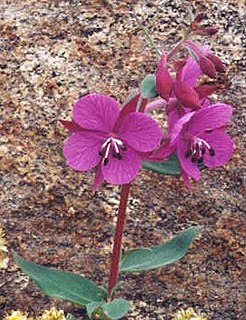
The Onagraceae are a family of flowering plants known as the willowherb family or evening primrose family. They include about 650 species of herbs, shrubs, and trees in 17 genera. The family is widespread, occurring on every continent from boreal to tropical regions.

Epilobium is a genus of flowering plants in the family Onagraceae, containing about 197 species. The genus has a worldwide distribution. It is most prevalent in the subarctic, temperate and subantarctic regions, whereas in the subtropics and tropics Epilobium species are restricted to the cool montane biomes, such as the New Guinea Highlands.
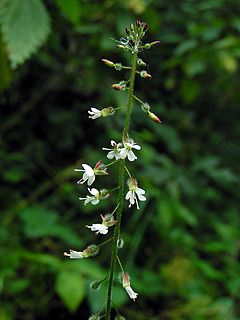
The genus Circaea contains 7–10 species of flowering plants, known as enchanter's nightshade, in the willowherb family, Onagraceae. They are woodland plants occurring in temperate regions of the Northern Hemisphere with one species, alpine enchanter's nightshade being widespread throughout the Northern Hemisphere. The broad-leaved enchanter's nightshade is found in Eurasia and the eastern enchanter's nightshade is found in North America. In addition, there is an intermediate hybrid between these two, and several local species or subspecies, with between eight and 14 forms recognised by different authorities. The hybrid is sterile, persisting only by vegetative reproduction and not producing seeds.

Proserpinus is a genus of moths in the family Sphingidae, the sphinx moths or hawk moths. Species of the genus are native to North America with the exception of P. proserpinus, which has a much larger range extending from Asia to Africa. The genus was erected by Jacob Hübner in 1819.

Chamaenerion is a genus of flowering plants in the family Onagraceae. It has sometimes been included in the genus Epilobium. Members of the genus may be called willowherbs, or fireweeds, based on a common name used for C. angustifolium. They are upright herbaceous perennials, growing from a woody base or from rhizomes, with racemes of usually purple to pink flowers. All species are found in the northern hemisphere. Most occur in moist habitats; C. angustifolium is the exception, favouring disturbed ground.
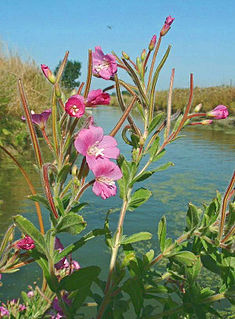
Epilobium hirsutum is a flowering plant belonging to the willowherb genus Epilobium in the family Onagraceae. It is commonly known as the great willowherb, great hairy willowherb or hairy willowherb. Local names include codlins-and-cream, apple-pie and cherry-pie.

Jens Wilken Hornemann was a Danish botanist.

Epilobium ciliatum, known by the common names fringed willowherb, American willowherb, slender willow herb, and northern willow herb is a species of flowering plant in the willowherb family Onagraceae. This species is native to much of North America, southern South America, and East Asia. It is an introduced species in much of Eurasia and Australia.

Epilobium minutum is a species of willowherb known by the common names little willowherb, chaparral willowherb and desert willowherb. It is also called "smallflower willowherb" in reference to its small size relatively. However that name, in particular the British English variant "small-flowered willowherb", typically refers to Epilobium parviflorum.

Epilobium septentrionale, with the common names Humboldt County fuchsia and northern willowherb, is a species of willowherb. Like the wildflower zauschneria, this plant was once treated as a member of genus Zauschneria but has more recently been placed with the willowherbs.
Fireweed is a perennial herbaceous plant in the willowherb family (Onagraceae).

Mompha epilobiella is a moth in the family Momphidae found in Europe and North America.
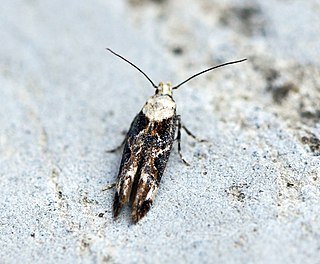
Mompha divisella is a moth in the family Momphidae. It found from southern Scandinavia to the Caucasus and central Asia.
Epilobium brunnescens is a flowering plant belonging to the willowherb genus Epilobium in the family Onagraceae. It is a small, creeping, perennial plant with white or pale pink flowers. It is native to New Zealand and south-east Australia and has been introduced to Northern Europe. Its common names include New Zealand willowherb in Great Britain and Ireland, creeping willowherb in New Zealand and bog willowherb for the Australian subspecies.

Diadasia is a genus of bees in family Apidae. Species of Diadasia are oligolectic, specialized on a relatively small number of plant species. Their host plants include asters, bindweeds, cacti, mallows, and willowherbs, although mallows are the most common and likely ancestral host plant for the whole genus. Its tribe is Emphorini. In the Sonoran Desert, Diadasia rinconis is considered the "cactus bee" as it feeds almost exclusively on a number of Sonoran Desert cactus species, its life cycle revolving around the flowering of the native species of cacti.

Epilobium lanceolatum, the spear-leaved willowherb, is a species in the genus Epilobium, belonging to the Onagraceae or "evening primrose" family. It grows between 30 and 60 cm high. This perennial plant has lance-shaped leaves, steadily narrowing to both ends, with long petioles; 5-7mm, grey to green-blue, with widely toothed margins. The flowers are white fading to pink; blooming from June to August. Epilobium lanceolatum occurs across western Europe.

Epilobium coloratum, known by the common names purpleleaf willowherb and cinnamon willow-herb, is a species of flowering plant in the genus Epilobium of the willowherb family Onagraceae. This species is native to the Midwest and Eastern United States, as well as the Canadian provinces of Ontario, Quebec, New Brunswick, Nova Scotia, and the island of Newfoundland.
















